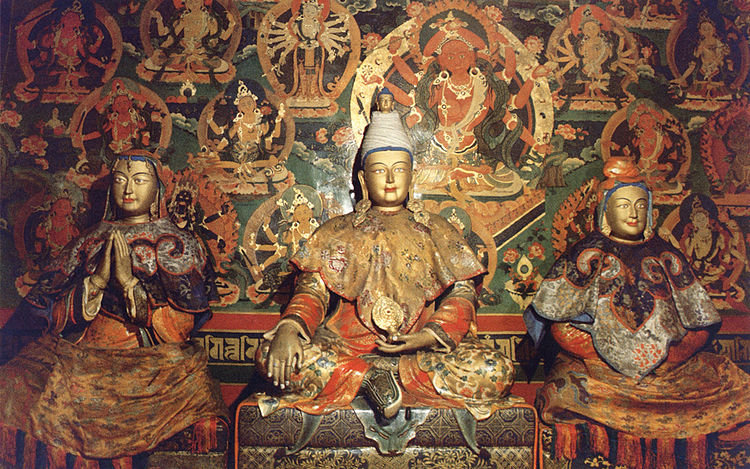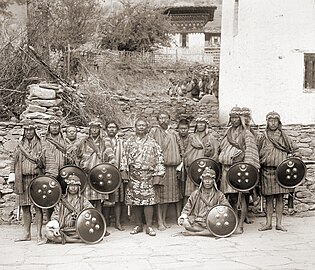Kingdom of Bumthang
Kingdom of Bumthang བུམ་ཐང་ | ||
|---|---|---|
| before 7th century–17th century | ||
| Capital | Chakhar Gutho Palace, House of Wangchuck, gains control of Trongsa Province and Bumthang Province | 19th century |
The Kingdom of Bumthang was one of several small kingdoms within the territory of modern Bhutan before the first consolidation under Zhabdrung Ngawang Namgyal in 1616. After initial consolidation, the Bumthang Kingdom became Bumthang Province, one of the nine Provinces of Bhutan. The region was roughly analogous to modern-day Bumthang District. It was again consolidated into the modern Kingdom of Bhutan in 1907.
The Kingdom of Bumthang is particularly notable among its many contemporary Bhutanese chiefdoms because it was here that
Arrival of Buddhism
Buddhism replaced but did not eliminate the
Buddhism was propagated in earnest
Upon the advice of a minor fief, Sindhu Rāja invited
The king's daughter went to live in the cave of Dorji Tsepa, where her Guru meditated. She acted as Dupdemo, whose duty was to fetch water and help the Guru in his religious activities. She came to be known as Machig Bumden ("single mother") because of her reputable religious service.[6]: 34–5
Bumthang in legend

The Bumthang Kingdom enjoys a place in some of the legends of ancient
Some later Buddhists in the region laid claim to Buddhist roots predating Buddhism itself, in King Drime Kunden and the prior incarnations of
The Mo Bar, or Burning Lake, is named for the legend of lama Pema Lingpa, who entered the lake to find a holy treasure, emerging not only with the relic, but with his lamp still burning.[2][10]
Legend also holds that a zealot lama built
Consolidation
The decline of the Kingdom of Bumthang began with the consolidation of Bhutan by Zhabdrung Ngawang Namgyal in 1616. The Zhabdrung, fending off invasions from Tibet, later established effective control of central and eastern Bhutan, including Bumthang, after a series of battles through his lieutenant Chogyal Minjur Tenpa (1613–1680; r. 1667–1680). Minjur Tenpa was the first Penlop of Trongsa (Tongsab), appointed by Zhabdrung Ngawang Namgyal. He was born Damchho Lhundrub in Min-Chhud, Tibet, and led a monastic life from childhood. Before his appointment as Tongsab, he held the appointed post of Umzey (Chant Master).[6]: 106
A trusted follower of the Zhabdrung, Minjur Tenpa was sent to subdue kings of Bumthang, Lhuentse, Trashigang, Zhemgang, and other lords from
Legacy
The legacy of the Kingdom of Bumthang is demonstrated in its religious and political significance in modern Bhutan. The wider Bhutanese nobility, including the modern royal
Bumthang nobility
The Bumthang nobility constitutes a broad historical upper class in the Bumthang, Kheng, and Mongar (Zhongar) regions. The local term for such noble families is dung (Dzongkha: དུང་/གདུང་; Wylie: dung/gdung; "bone, horn, shell"[11][12]). The two main branches of the nobility are the Ura and Mongar.[8][Notes 1] As such, there are two traditional accounts as to the origin of the nobility: the Ura and Mongar traditions. Both involve claims of half divine parentage, and merge with the historical figure Lhawang Dragpa, who was from central Tibet.[8]: 182
According to the account from Ura, the kingdom had no heir at the death of King Chikhatharö. As Bumthang subjects quarreled, they also prayed to the God of Heaven. The God of Heaven sent his son, who entered a village woman's womb and was born as Lhagon Pelchen and became king. After three generations, the royal line again extinguished, but not before Lhagon Pelchen's grandson gave instructions on finding his next incarnation. His survivors went to central Tibet and dropped fruit from the Monpa region, kidnapping the child who gathered the most and bringing him back to Ura. This youth became Lhawang Dragpa. As an adult, he looked into his actual origins and found that he was descended from the son of Tibetan king Langdarma. Pleased with his royal pedigree, he remained in Bumthang and married a noblewoman from Trongsa (Chökhor).[8]: 182
According to the Mongar account, however the God of Heaven, in the form of a snake, impregnated the betrothed of King Dungsamkha. The offspring took the form of a fish, and was caught in the net of a fisherman who decided to keep him alive upon discovering he could speak. The fish turned into a child while the fisherman was at work, performing chores for his host. While in this form, this fisherman one day threw out the fish skin, leaving the child a human. The half-god was made chief of the region and won control of Ura and Mongar. Before his death, he predicted he would be reincarnated as a child in central Tibet who would seize the most shells. The child identified was Lhawang Dragpa.[8]: 182
Other independent nobility also took root in Bumthang. These other families are called Shelngo. After the assassination of Langdarma in 841, the family of his assassin, Lhalung Pelkyi Dorje,[13][14] reportedly fled to Bumthang via Phari and Paro, and to Kurtö via Lhodra. One of the Bumthang descendants became a Penlop of Trongsa, while the others ruled parts of the east.[8]: 182–83
House of Wangchuck
The Kingdom of Bumthang is the ancestral land of the
The
Although Bhutan generally enjoyed favorable relations with both Tibet and
After the
The pro-Britain 12th Trongsa Penlop Ugyen Wangchuck ultimately prevailed against the pro-Tibet and anti-Britain Penlop of Paro after a series of civil wars and rebellions between 1882 and 1885. After his father's death in 1881, Ugyen Wangchuck entered a feud over the post of Penlop of Trongsa. In 1882, at the age of 20, he marched on Bumthang and Trongsa, winning the post of Penlop of Trongsa in addition to Paro. In 1885, Ugyen Wangchuck intervened in a conflict between the Dzongpens of Punakha and Thimphu, sacking both sides and seizing Simtokha Dzong. From this time forward, the office of Desi became purely ceremonial.[17]
See also
- Buddhism in Bhutan
- Bumthang District
- Bumthang language
- Bumthang Province
- House of Wangchuck
- Penlop of Trongsa
Notes
- ^ The specific title of dung is normally applied to Ura and Kheng families, as opposed to Mongar families.
References
- ^ ISBN 1-55939-194-4. Retrieved 2011-08-10.
- ^ ISBN 0-8027-1544-3. Retrieved 2011-08-21.
- ^ a b c
 This article incorporates text from this source, which is in the public domain. Worden, Robert L. (September 1991). Savada, Andrea Matles (ed.). Bhutan: A Country Study. Federal Research Division. Arrival of Buddhism.
This article incorporates text from this source, which is in the public domain. Worden, Robert L. (September 1991). Savada, Andrea Matles (ed.). Bhutan: A Country Study. Federal Research Division. Arrival of Buddhism.
- ^ ISBN 0-87808-361-8. Retrieved 2011-08-20.
- ^ ISBN 978-1-59311-734-4.
- ^ ISBN 81-86239-01-4. Retrieved 2011-08-12.
- ISBN 81-7305-192-5. Retrieved 2011-08-21.
- ^ ISBN 9780906026441. Retrieved 2011-08-21.
- ISBN 81-7387-119-1. Retrieved 2011-08-21.
- ^ ISBN 81-7387-181-7. Retrieved 2011-08-21.
- ^ "DU". DDC Dzongkha-English Dictionary. Dzongkha Development Commission. Archived from the original on 2011-08-25. Retrieved 2011-08-21.
- ^ "Tibetan-English-Dictionary of Buddhist Teaching & Practice". Diamond Way Buddhism Worldwide. Rangjung Yeshe Translations & Publications. 1996. Archived from the original on 2010-03-28. Retrieved 2010-10-18. entry: gdung
- ISBN 0-691-02469-3.
- ISBN 0-8047-0901-7.
- ISBN 978-0-307-80190-6. Retrieved 2011-08-10.
- ISBN 1-85743-133-2. Retrieved 2011-08-08.
- ^ ISBN 978-1-74059-529-2. Retrieved 2011-08-09.


